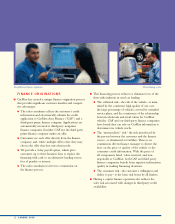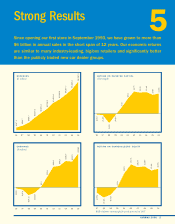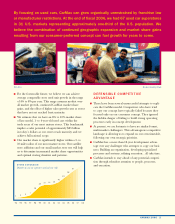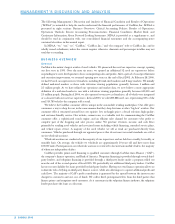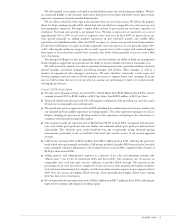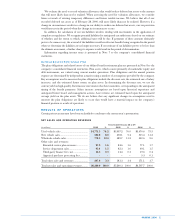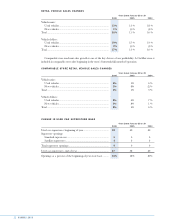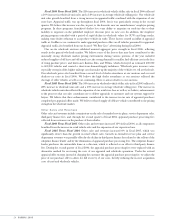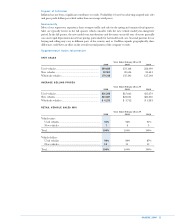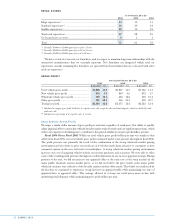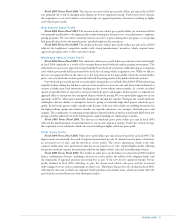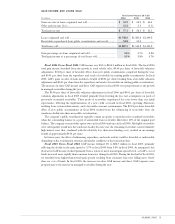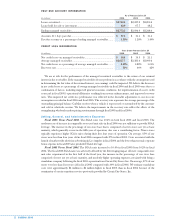CarMax 2006 Annual Report Download - page 22
Download and view the complete annual report
Please find page 22 of the 2006 CarMax annual report below. You can navigate through the pages in the report by either clicking on the pages listed below, or by using the keyword search tool below to find specific information within the annual report.
20
CARMAX 2006
CRITICAL ACCOUNTING POLICIES
Our results of operations and financial condition as reflected in the company’s consolidated financial
statements have been prepared in accordance with accounting principles generally accepted in the United
States of America. Preparation of financial statements requires management to make estimates and
assumptions affecting the reported amounts of assets, liabilities, revenues, and expenses, and the disclosures
of contingent assets and liabilities. We use our historical experience and other relevant factors when
developing our estimates and assumptions. We continually evaluate these estimates and assumptions. Note 2
to the company’s consolidated financial statements includes a discussion of significant accounting policies.
The accounting policies discussed below are the ones we consider critical to an understanding of the
company’s consolidated financial statements because their application places the most significant demands
on our judgment. Our financial results might have been different if different assumptions had been used or
other conditions had prevailed.
Securitization Transactions
We use a securitization program to fund substantially all of the automobile loan receivables originated by
CAF. The securitization transactions are accounted for as sales in accordance with Statement of Financial
Accounting Standards (“SFAS”) No. 140, “Accounting for Transfers and Servicing of Financial Assets and
Extinguishments of Liabilities.” A gain, recorded at the time of the securitization transaction, results from
recording a receivable approximately equal to the present value of the expected residual cash flows
generated by the securitized receivables. The fair value of our retained interest includes the present value of
the expected residual cash flows generated by the securitized receivables, various reserve accounts, and an
undivided ownership interest in securitized receivables.
The present value of the expected residual cash flows generated by the securitized receivables is
determined by estimating the future cash flows using management’s assumptions of key factors, such as
finance charge income, default rates, prepayment rates, and discount rates appropriate for the type of asset
and risk. These assumptions are derived from historical experience and projected economic trends.
Adjustments to one or more of these assumptions may have a material impact on the fair value of the
retained interest. The fair value of the retained interest may also be affected by external factors, such as
changes in the behavior patterns of customers, changes in the economy, and developments in the interest
rate markets. Note 2(C) to the company’s consolidated financial statements includes a discussion of
accounting policies related to securitizations. Note 4 to the company’s consolidated financial statements
includes a discussion of securitizations and provides a sensitivity analysis showing the hypothetical effect on
the retained interest if there were variations from the assumptions used. In addition, see the “CarMax Auto
Finance Income” section of this MD&A for a discussion of the impact of changing our assumptions.
Revenue Recognition
We recognize revenue when the earnings process is complete, generally either at the time of sale to a customer
or upon delivery to a customer. The majority of our revenue is generated from the sale of used vehicles. We
recognize vehicle revenue when a sales contract has been executed and the vehicle has been delivered, net of a
reserve for returns under our 5-day, money-back guarantee. A reserve for vehicle returns is recorded based on
historical experience and trends.
We also sell extended service plans on behalf of unrelated third parties to customers who purchase a
vehicle. Because these third parties are the primary obligors under these programs, we recognize commission
revenue on the extended service plans at the time of the sale, net of a reserve for estimated service plan returns.
The estimated reserve for returns is based on historical experience and trends.
The estimated reserves for returns could be affected if future vehicle or service plan return occurrences
differ from historical averages.
Income Taxes
Estimates and judgments are used in the calculation of certain tax liabilities and in the determination of the
recoverability of certain of the deferred tax assets. In the ordinary course of business, transactions occur for
which the ultimate tax outcome is uncertain at the time of the transactions. We adjust our income tax
provision in the period in which we determine that it is probable that our actual results will differ from our
estimates. Tax law and rate changes are reflected in the income tax provision in the period in which such
changes are enacted.




